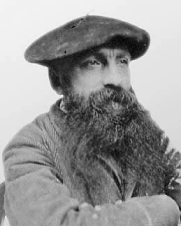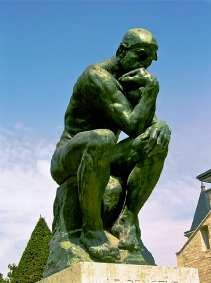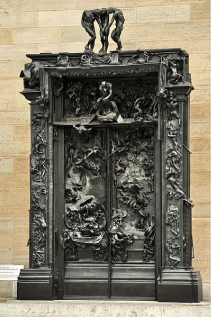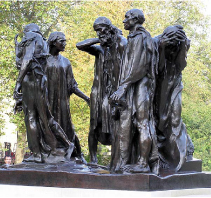Hey Kids, Meet Auguste Rodin
from the Hey Kid's, Meet the Artist! Index
 |
Auguste Rodin
(1840-1917) French Artist
Preview and Print
Preview and print this free printable artist biography by clicking on the orange button.

|
François-Auguste-René Rodin was born in a poor section of Paris, France, on November 12, 1840. He was the second son of Jean-Baptiste Rodin and Marie Cheffer. His father was employed as a clerk at the police department. He had one sister, Maria, who was two years older. Because of his nearsightedness, Auguste struggled in school, but seemed to find contentment while drawing. Largely self-taught up to the age of 13, he began his formal schooling at the age of 14 at Ecole Imperiale Speciale de Dessin et de Mathematiques, where he studied painting and drawing. For the next four years, he learned the basic skills of an artist.
After Auguste was rejected entrance three times to the respected Ecole des Beaux-Arts, he left the world of traditional art and took a job as a craftsman, making decorative stonework. In 1862, when his sister Marie died from infection, it left Auguste devastated. Heart-broken and confused, Auguste turned to priest Father Pierre-Julien Eymard to help him through his grief. Father Eymard encouraged Auguste to pursue his passion for the art of sculpting.
For the next several years, Rodin struggled to support himself financially. He traveled to Belgium for work, and then to Italy in 1875, where he was profoundly impacted by the sculptures of Michelangelo. After he returned to Paris in 1877, he completed his first sculpture that would attract the attention of the art community. Rodin then accepted a job as a designer of vases and other ornaments for the home. It was because of these decorative works that opportunities to work as an artist opened up for Rodin, and in 1880, he was commissioned to create one his best works, The Gates of Hell. This sculpture, which depicts the first section of Dante Alighieri's epic poem Divine Comedy, was supposed to be completed by 1895, but Rodin worked on it for the last 37 years of his life. While working on this, he also created a sculpture which represents Dante at the Gates of Hell. This work is Rodin's most famous work, The Thinker.
Auguste Rodin died on November 17, 1917, in Meudon, France. He is remembered most for his sculptures, including the The Burghers of Calais, The Gates of Hell, and the famous sculpture, The Thinker.
Auguste Rodin Lesson Resources
Auguste Rodin | Word Search Worksheet
Goldfish Soap Sculpture | Sculpture Lesson
"Meet the Artist" Job Application | Worksheet
Auguste Rodin Art Gallery
 |
The Thinker (1902) by Auguste Rodin |
Bronze Sculpture
The Thinker was initially a figure created for The Gates of Hell. The work shows a larger than life-size man sitting on a rock with his chin resting on one hand as if to be deep in thought. The work was named The Thinker by foundry workers, who saw a certain similarity to Michelangelo's sculpture of Lorenzo de Medici called "Il Penseroso" (The Thinker).
|
 |
Gates of Hell (1880-1917) by Auguste Rodin |
Bronze Doors
Gates of Hell is a monumental sculpture depicting a scene from "The Inferno", the first section of Dante Alighieri's Divine Comedy. It stands at 19 feet high, 13 feet wide and 3 feet deep, with 180 figures. Some of the figures created for this project became separate and independent works, including The Thinker, The Three Shades, and The Kiss.
|
 |
The Burghers of Calais (1884-1889) by Auguste Rodin |
Bronze Sculpture
The Burghers of Calais was commissioned by the town of Calais to commemorate the six citizens of Calais who gave their lives to save their fellow townspeople. It is one of Rodin's most acclaimed works.
|

|